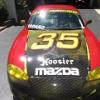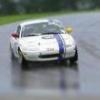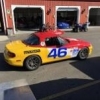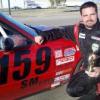
Mazda Front Hubs vs Aftermarket Front Hubs: Heat Treat and Life
#21

 Posted 12-20-2012 12:19 PM
Posted 12-20-2012 12:19 PM

#22

 Posted 12-20-2012 12:56 PM
Posted 12-20-2012 12:56 PM

How come? No one wants to talk about the photo in post 1 that shows 1 hub with 2 induction hardning bands and 1 hub with 1 induction hardning band.
Everyone likes to talk about grease, Hmmm.
"Special grease" has a catchier ring to it than "Special induction hardening"?



#23

 Posted 12-20-2012 01:08 PM
Posted 12-20-2012 01:08 PM

I wonder if the aftermarket hub is a multi-part hub, where the hub is heated for expansion and the race inserted.How come? No one wants to talk about the photo in post 1 that shows 1 hub with 2 induction hardning bands and 1 hub with 1 induction hardning band.
Everyone likes to talk about grease, Hmmm.
Chris
Happiness is a dry martini and a good woman ... or a bad woman.
- George Burns
#24

 Posted 12-20-2012 01:22 PM
Posted 12-20-2012 01:22 PM

"Special grease" has a catchier ring to it than "Special induction hardening"?
Grease and hardening, back to my original comment, Hmmm.
Come on Keith, your an engineer. This should be in your wheel house.
I wonder if the aftermarket hub is a multi-part hub, where the hub is heated for expansion and the race inserted.
Good thought. Wilson, care to inspect the hubs furthher?
For my 2 cents, I'd bet the races are maching in the hubs and not separate of the hub.



#25

 Posted 12-20-2012 01:50 PM
Posted 12-20-2012 01:50 PM

#26

 Posted 12-20-2012 01:59 PM
Posted 12-20-2012 01:59 PM

OTOH, maybe that explains the early failure, if the race really is the same hardness as the rest of the hub.
Jim, at least your in the communication about the two different hubs. From my perspective, how could the area of the outer bearing outer race location be hard with no dis-color renants from induction hardening.



#27

 Posted 12-20-2012 01:59 PM
Posted 12-20-2012 01:59 PM

I've always had a theory that it's the amount of camber run in the spec miatas, I run in FP with slicks, put new bearings in 4 years ago, did nothing to them except longer studs and they're still good. Of course I just jinxed that and will now change them over the winter, but they haven't skipped a beat.
Interesting. But I'm thinking your car is a lot lighter, your wheel/tire weight is a lot lighter, your wheel offset isn't as nutty, and you don't blitz the curbs like the SM "monster trucks"?
For faster reply than PM: miataboxes>>>AT<<<gmail>>DOT<<<com
#28

 Posted 12-20-2012 02:02 PM
Posted 12-20-2012 02:02 PM

"Special grease" has a catchier ring to it than "Special induction hardening"?
As you said elsewhere, you can't polish a turd ... maybe you can't grease one or harden one, either?!
For faster reply than PM: miataboxes>>>AT<<<gmail>>DOT<<<com
#29

 Posted 12-20-2012 02:29 PM
Posted 12-20-2012 02:29 PM

I highly doubt the races are separate. If they were, it's typical to freeze the inside part with liquid Nitrogen so it shrinks rather than heat the outside part so it expands. It's quick and convinient plus it doesn't mess with the metal properties of the outside part. If you have a tank of it laying around, that's the easy way to insert "freeze plugs."
Castings are an easy way to make parts but the metal tends to be the weakest. When the metal cools, the molecules are randomly arranged like dumping a bunch of nails into a jar. They aren't sitting nicely against one another and there are lots of little gaps. Heat treating is like shaking the jar of nails so they settle in and pack tighter to add a few more. The heat makes the metal molecules move around easier so they can find a happy place. That packs them in tighter so the metal is stronger and thermal expansion is less. Forging and shot peening does the same thing but using brute force.
Since it's a casting with a bearing surface, it makes sense to machine and heat treat the races to get a smoother harder surface but why just one race? My guess is that both races are heat treated on both parts but you can only see the bluing on one side with the Mazda part. The one where you can see it on the Mazda part has a nice clean line at the boundary compared to the other part...tighter/more controlled processing. The one where you can't see it is on a thicker section. With tighter processing, the heat treating will be more local and won't show all the way through just like the whole part isn't blue on either hub. It may just be that on the white box part, they simply heated the living he11 out of the bearing races and called it good.



#30

 Posted 12-20-2012 03:09 PM
Posted 12-20-2012 03:09 PM

Since it's a casting with a bearing surface, it makes sense to machine and heat treat the races to get a smoother harder surface but why just one race? My guess is that both races are heat treated on both parts but you can only see the bluing on one side with the Mazda part.
The hardness tester agrees with you, Keith ... at least on the "good" bearings. Some of the bad ones have been 14 Rc less in one race or another, and 20+ Rc less than the inner races.
But what do you mean about doubting the races are separate? They aren't pressed-in on any stock OEM or A/M revision I've seen, if that's what you mean.
For faster reply than PM: miataboxes>>>AT<<<gmail>>DOT<<<com
#31

 Posted 12-20-2012 03:20 PM
Posted 12-20-2012 03:20 PM

They aren't pressed-in on any stock OEM or A/M revision I've seen, if that's what you mean.
That's what I meant. I have seen steel races pressed into aluminum parts. The stock and white box hubs I've disassembled but not cut apart all looked like a one piece unit.



#32

 Posted 12-20-2012 05:45 PM
Posted 12-20-2012 05:45 PM

The hardness tester agrees with you, Keith ... at least on the "good" bearings. Some of the bad ones have been 14 Rc less in one race or another, and 20+ Rc less than the inner races.
Mark, being that you have completed some hub race hardness testing, what was the actual hardness of the hub area of the outer race for the inside bearing and the actual hardness of the hub area of the outer race for the outside bearing .
What was the hardness of an un-hardened area of the same hub?



#33

 Posted 12-20-2012 06:31 PM
Posted 12-20-2012 06:31 PM

Clowns are often wrong about these things, but at least we can provide a bad example.
YUUUP
We have all been there.
Frank
TnT Racing
SCCA Ohio Valley Region




#34

 Posted 12-20-2012 08:02 PM
Posted 12-20-2012 08:02 PM

That's what I meant. I have seen steel races pressed into aluminum parts. The stock and white box hubs I've disassembled but not cut apart all looked like a one piece unit.
While a visual inspection might indicate that it WAS a two-piece assembly, I'm not sure you can trust it to indicate that it wasn't. Has anybody tried cutting a race?
#35

 Posted 12-20-2012 09:55 PM
Posted 12-20-2012 09:55 PM

Mark, being that you have completed some hub race hardness testing, what was the actual hardness of the hub area of the outer race for the inside bearing and the actual hardness of the hub area of the outer race for the outside bearing .
What was the hardness of an un-hardened area of the same hub?
Doh, you asked me at least 105 minutes too late
BUT - the surface hardness ain't everything, you need some toughness under the surface in order to take the shock loading. I don't really have a way to test for that, I just figure if the bearing supplier is ALREADY well below 55 Rc and can't control his process from race to race or bearing to bearing, then there is likely to be some additional "fire" behind that "smoke".
For faster reply than PM: miataboxes>>>AT<<<gmail>>DOT<<<com
#36

 Posted 02-06-2013 10:57 AM
Posted 02-06-2013 10:57 AM

Too much grease causes heat build-up, and not enough causes the bearing to run dry. Google your heart out, any bearing or grease expert will tell you generally the same thing. There are always exceptions.
The Miata bearings, both front and rear, have some room for too much grease to find a home in between the races - and this is the only thing saving those that believe "more grease is more better".
Skeptics will find comfort here: http://www.ntn.co.jp...en_a072-079.pdf
Saul, do you know what the base oil is for the CV-2? I am just curious to look at info relevant to a grease I have used.
thanks
- Speed



#37

 Posted 02-06-2013 01:33 PM
Posted 02-06-2013 01:33 PM

I've always had a theory that it's the amount of camber run in the spec miatas, I run in FP with slicks, put new bearings in 4 years ago, did nothing to them except longer studs and they're still good. Of course I just jinxed that and will now change them over the winter, but they haven't skipped a beat.
I run an unusual amount of camber and I've replaced one bearing in ten years - I've never repacked one either. I'm not the fastest but I am overly aggressive. I never understood the high failure rates, but then I almost always use original OEM bearings from 1990, I just assumed the newer bearings were not of the same quality.
BTDTRacing, LLC - ISellMiataParts.com
"I'm not making any money doing this, I'm purely doing it out of ego." - Paul Tracy
2011 Midwestern Council Spec Miata series champion
2015 Winner, SM - Midwestern Council: A Legen-Dairy Enduro, Co-Driver Stephanie Andersen
2015 Winner, ITA - Midwestern Council, Blackhawk Formula Festival




#38

 Posted 02-09-2013 09:49 AM
Posted 02-09-2013 09:49 AM

Saul, do you know what the base oil is for the CV-2? I am just curious to look at info relevant to a grease I have used.
thanks
I do not, but there are some nuggets of credible-sounding information at BobIsTheOilGuy.Com. Grease is voodoo just like oil. From a spec standpoint, CV-2 has an extremely high dropping point ... but it also tends to separate more than other "bearing greases".
More importantly than the grease itself, I think most people are putting in too much grease, and possibly mixing incompatible greases. I feel like I see a lot of failed bearings with CV-2 in them, but this is most likely simply because MOST people are using CV-2.
Also - just because your bearing's inner races say NTN/Koyo/SKF, etc., the part that fails is still the CASTING ino which the outer race is machined. For the majority of hubs out there, NTN/Koyo/SKF are not making that part. Keeping track of whose casting vendor is doing a good job is an expensive and time-consuming proposition.
Frankly, Blake T is the smartest guy in the room, because if there was ever a time where quality was being watchdogged on this part number, it was during its use in current production.
(In contrast, the Miata rear bearings are really a FWD front bearing, are still used in new cars, and have had some improvements made over the years).
For faster reply than PM: miataboxes>>>AT<<<gmail>>DOT<<<com
#39

 Posted 02-11-2013 02:57 PM
Posted 02-11-2013 02:57 PM

I do not, but there are some nuggets of credible-sounding information at BobIsTheOilGuy.Com. Grease is voodoo just like oil. From a spec standpoint, CV-2 has an extremely high dropping point ... but it also tends to separate more than other "bearing greases".
More importantly than the grease itself, I think most people are putting in too much grease, and possibly mixing incompatible greases. I feel like I see a lot of failed bearings with CV-2 in them, but this is most likely simply because MOST people are using CV-2.
Also - just because your bearing's inner races say NTN/Koyo/SKF, etc., the part that fails is still the CASTING ino which the outer race is machined. For the majority of hubs out there, NTN/Koyo/SKF are not making that part. Keeping track of whose casting vendor is doing a good job is an expensive and time-consuming proposition.
Frankly, Blake T is the smartest guy in the room, because if there was ever a time where quality was being watchdogged on this part number, it was during its use in current production.
(In contrast, the Miata rear bearings are really a FWD front bearing, are still used in new cars, and have had some improvements made over the years).
The only downside is I think that extra long life grease and hundreds of thousands of miles probably leaves a couple miles an hour of resistance out there for my competitors. But, I have buckets of untouched bearing cassettes, so by all means, buy them and prove me wrong.
BTDTRacing, LLC - ISellMiataParts.com
"I'm not making any money doing this, I'm purely doing it out of ego." - Paul Tracy
2011 Midwestern Council Spec Miata series champion
2015 Winner, SM - Midwestern Council: A Legen-Dairy Enduro, Co-Driver Stephanie Andersen
2015 Winner, ITA - Midwestern Council, Blackhawk Formula Festival




#40

 Posted 08-18-2013 07:25 PM
Posted 08-18-2013 07:25 PM

Ok, was February really the last time anyone commented on Hubs and Bearings? Anyway, I see many posts referencing trial of different types of hubs/bearings? Aftermarket and OEM varieties. But I can't find anything in the GCR that states what variety of hubs and bearings you can use. What am I missing? What spec hubs can one use? Anything that was designed for a Miata?
--because someone commented that we should all post our names, and not be anonymous. I agree.


0 user(s) are reading this topic
0 members, 0 guests, 0 anonymous users




 Sign In
Sign In Create Account
Create Account


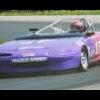

 Back to top
Back to top Report
Report



